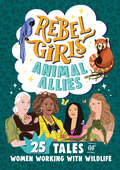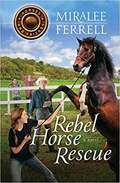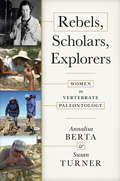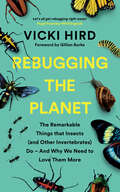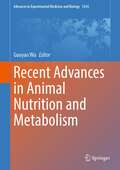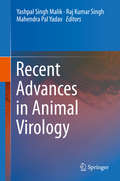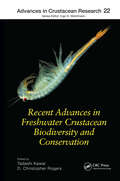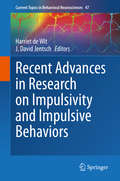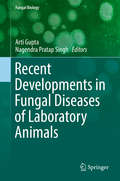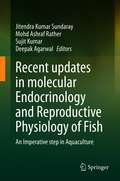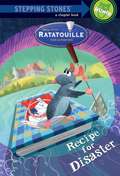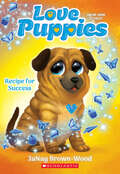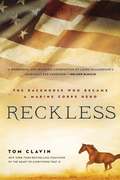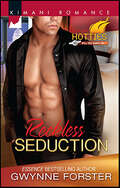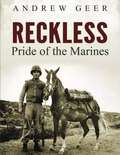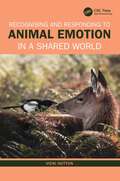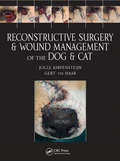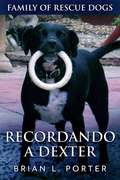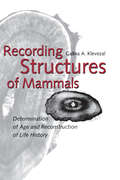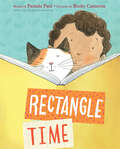- Table View
- List View
Rebel Girls Animal Allies: 25 Tales of Women Working with Wildlife (Rebel Girls Minis)
by Lucy King Rebel GirlsTRUE STORIES OF ANIMAL ADVOCATESMeet 25 brave, compassionate scientists, veterinarians, activists, and others who fight for animal rights and conservation. Animal Allies takes readers all around the world—to the tops of trees and the bottom of oceans, deep into the jungle and high into the mountains.Swim with the sharks alongside Eugenie Clark, build bat houses with Amanda Lear, nurse a baby hippo to health with Christina Gorsuch, and protect endangered seahorses with Amanda Vincent and Heather Koldewey.With a foreword by zoologist Lucy King and activities curated by conservationist Bindi Irwin, this book is sure to inspire animal lovers everywhere. Plus, scannable codes let you listen to longer stories on the Rebel Girls App!
Rebel Horse Rescue: Horses and Friends
by Miralee FerrellSummer is winding down for Kate and her friends when a surprise visitor appears at her family’s stable—a beautiful bay horse wearing a halter and a bad attitude. Dubbing the horse “Rebel,” the friends set out to find the horse’s owner. Where did he come from, and why are horses all over the area disappearing from their pastures and paddocks? It’s a mystery that even the sheriff can’t figure out, so Kate decides to head up the investigation. When Kate’s autistic brother, Pete, develops a strong connection to the new arrival, Kate wonders—did God bring Rebel to them for a bigger purpose? A perfect book for kids ages 9-13, containing mystery, adventure, family values, friendships, and lots of horses! Each of the books in the Horses and Friends books can be read alone, but each one builds on the other as to character development and story line.
Rebels, Scholars, Explorers: Women in Vertebrate Paleontology
by Annalisa Berta Susan TurnerUnearthing the amazing hidden stories of women who changed paleontology forever.For centuries, women have played key roles in defining and developing the field of vertebrate paleontology. Yet very little is known about these important paleontologists, and the true impacts of their contributions have remained obscure. In Rebels, Scholars, Explorers, Annalisa Berta and Susan Turner celebrate the history of women "bone hunters," delving into their fascinating lives and work. At the same time, they explore how the discipline has shaped our understanding of the history of life on Earth.Berta and Turner begin by presenting readers with a review of the emergence of vertebrate paleontology as a science, emphasizing the contributions of women to research topics and employment. This is followed by brief biographical sketches and explanations of early discoveries by women around the world over the past 200 years, including those who who held roles as researchers, educators, curators, artists, and preparators. Forging new territory, Berta and Turner highlight the barriers and challenges faced by women paleontologists, describing how some managed to overcome those obstacles in order to build careers in the field. Finally, drawing on interviews with a diverse group of contemporary paleontologists, who share their experiences and offer recommendations to aspiring fossil hunters, they provide perspectives on what work still needs to be done in order to ensure that women's contributions to the field are encouraged and celebrated. Uncovering and relating lost stories about the pivotal contributions of women in vertebrate paleontology doesn't just make for enthralling storytelling, but also helps ensure a richer and more diverse future for this vibrant field. Illuminating the discoveries, collections, and studies of fossil vertebrates conducted by women in vertebrate paleontology, Rebels, Scholars, Explorers will be on every paleontologist's most-wanted list and should find a broader audience in the burgeoning sector of readers from all backgrounds eager to learn about women in the sciences.
Rebugging the Planet: The Remarkable Things that Insects (and Other Invertebrates) Do And Why We Need to Love Them More
by Vicki Hird"This is a lovely little book that could and should have a big impact...Let&’s all get rebugging right away!"—Hugh Fearnley-WhittingstallMeet the intelligent insects, marvelous minibeasts, and inspirational invertebrates that help shape our planet—and discover how you can help them help us by rebugging your attitude today!Remember when there were bugs on your windshield? Ever wonder where they went? We need to act now if we are to help the insects survive. Robin Wall Kimmerer, David Attenborough, and Elizabeth Kolbert are but a few voices championing the rewilding of our world. Rebugging the Planet explains how we are headed toward &“insectageddon&” with a rate of insect extinction eight times faster than that of mammals or birds, and gives us crucial information to help all those essential creepy-crawlies flourish once more.Author Vicki Hird passionately demonstrates how insects and invertebrates are the cornerstone of our global ecosystem. They pollinate plants, feed birds, support and defend our food crops, and clean our water systems. They are also beautiful, inventive, and economically invaluable—bees, for example, contribute an estimated $235 to $577 billion to the US economy annually, according to Forbes.Rebugging the Planet shows us small changes we can make to have a big impact on our littlest allies:• Learn how to rewild parks, schools, sidewalks, roadsides, and other green spaces.• Leave your garden to grow a little wild and plant weedkiller-free, wildlife-friendly plants.• Take your kids on a minibeast treasure hunt and learn how to build bug palaces.• Make bug-friendly choices with your food and support good farming practices• Begin to understand how reducing inequality and poverty will help nature and wildlife too—it&’s all connected.So do your part and start rebugging today! The bees, ants, earthworms, butterflies, beetles, grasshoppers, ladybugs, snails, and slugs will thank you—and our planet will thank you too.
Rebugging the Planet: The Remarkable Things that Insects (and Other Invertebrates) Do – And Why We Need to Love Them More
by Vicki Hird"This is a lovely little book that could and should have a big impact...Let’s all get rebugging right away!"—Hugh Fearnley-Whittingstall Meet the intelligent insects, marvelous minibeasts, and inspirational invertebrates that help shape our planet—and discover how you can help them help us by rebugging your attitude today! Remember when there were bugs on your windshield? Ever wonder where they went? We need to act now if we are to help the insects survive. Robin Wall Kimmerer, David Attenborough, and Elizabeth Kolbert are but a few voices championing the rewilding of our world. Rebugging the Planet explains how we are headed toward “insectageddon” with a rate of insect extinction eight times faster than that of mammals or birds, and gives us crucial information to help all those essential creepy-crawlies flourish once more. Author Vicki Hird passionately demonstrates how insects and invertebrates are the cornerstone of our global ecosystem. They pollinate plants, feed birds, support and defend our food crops, and clean our water systems. They are also beautiful, inventive, and economically invaluable—bees, for example, contribute an estimated $235 to $577 billion to the US economy annually, according to Forbes. Rebugging the Planet shows us small changes we can make to have a big impact on our littlest allies: Learn how to rewild parks, schools, sidewalks, roadsides, and other green spaces. Leave your garden to grow a little wild and plant weedkiller-free, wildlife-friendly plants. Take your kids on a minibeast treasure hunt and learn how to build bug palaces. Make bug-friendly choices with your food and support good farming practices Begin to understand how reducing inequality and poverty will help nature and wildlife too—it’s all connected. So do your part and start rebugging today! The bees, ants, earthworms, butterflies, beetles, grasshoppers, ladybugs, snails, and slugs will thank you—and our planet will thank you too.
Recent Advances in Animal Nutrition and Metabolism (Advances in Experimental Medicine and Biology #1354)
by Guoyao WuThis book covers hot topics in the nutrition and metabolism of terrestrial and aquatic animals, including the interorgan transport and utilization of water, minerals, amino acids, glucose, and fructose; the development of alternatives to in-feed antibiotics for animals (e.g., swine and poultry); and metabolic disorders (or diseases) resulting from nutrient deficiencies. It enables readers to understand the crucial roles of nutrients in the nutrition, growth, development, and health of animals. Such knowledge has important implications for humans. Readers will also learn from well-written chapters about the use of new genome-editing biotechnologies to generate animals (e.g., cows and swine) as bioreactors that can produce large amounts of pharmaceutical proteins and other molecules to improve the health and well-being of humans and other animals, as well as the growth and productivity of farm animals. Furthermore, the book provides useful information on the use of animals (e.g., cattle, swine, sheep, chickens, and fish) as models in biomedical research to prevent and treat human diseases, develop infant formulas, and improve the cardiovascular and metabolic health of offspring with prenatal growth restriction. Editor of this book is an internationally recognized expert in nutrition and metabolisms. He has about 40 years of experience with research and teaching at world-class universities in the subject matters. He has published more than 660 papers in peer-reviewed journals, 90 chapters in books, and authored two text/reference books, with a very high H-index of 127 and more than 66,000 citations in Google Scholar. This publication is a useful reference for nutrition and biomedical professionals, as well as undergraduate and graduate students in animal science, aquaculture, zoology, wildlife, veterinary medicine, biology, biochemistry, food science, nutrition, pharmacology, physiology, toxicology, and other related disciplines. In addition, all chapters provide general and specific references to nutrition and metabolism for researchers and practitioners in animal agriculture (including aquaculture), dietitians, animal and human medicines, and for government policy makers.
Recent Advances in Animal Virology
by Yashpal Singh Malik Raj Kumar Singh Mahendra Pal YadavThis book discusses the prominence and implication of the viral diseases that are a major threat to animals around the globe. A number of these diseases have also shown links with human populations, which has implications for public health. This book offers detailed and up-to-date information on viral diseases in livestock and poultry that were and/or are still a problem. Including cutting-edge developments, it also highlights several landmark contributions in the field of virology from India. Additionally, the book features tables and figures showing important clinical data and recommendations, with references for further information. It also explores the economic impact of viral diseases for farmers and the livestock industry, providing several examples. Further, it presents the latest information on viral diseases in global context, with a focus on state-of-art, molecular tools for the development of diagnostics, prophylactics and therapeutics. Lastly, the book also describes the challenges posed by the emerging and transboundary viral infections and our preparedness to counter them.
Recent Advances in Freshwater Crustacean Biodiversity and Conservation (Advances in Crustacean Research #22)
by Tadashi Kawai and D. Christopher RogersRecent Advances in Freshwater Crustacean Biodiversity and Conservation focuses on minor crustacean groups and regionally endemic groups, all from freshwaters. Chapters in this book cover crustaceans such as Maxillopods, Mysids, Cumaceans, Isopods, Amphipods, Branchiopods, Copepods, and Decapods. Each looks at global or regional fauna and discusses conservation issues for that group. The majority of the chapters are based on papers presented at symposia organized by the editors at two international scientific meetings held in Barcelona and Washington DC. The contributors are world-renowned experts on their groups, as well as on freshwater crustacean conservation and biodiversity at global levels. It has previously been difficult for conservation managers, NGOs, and university professors and students who may not have access to comprehensive journal subscriptions to find relevant information on diversity and conservation of freshwater crustaceans. This book meets that need, addressing crustacean groups not previously treated and providing additional information beyond any presented in existing books. As the editors write in their introduction: we cannot conserve and we cannot protect what we do not know exists. This is a reliable, cutting-edge reference for anybody involved in crustacean research: students, researchers, agencies, and NGOs, as well as science educators, conservationists, and government conservation policymakers. The book will also be useful for those working in aquaculture and fisheries, given that many of the taxa discussed are economically important.
Recent Advances in Research on Impulsivity and Impulsive Behaviors (Current Topics in Behavioral Neurosciences #47)
by Harriet De Wit J. David JentschThis volume provides an empirical and conceptual overview of advances in our understanding of impulsivity and impulsive behaviors. Prominent scientists review the range of behavioral phenomena referred to as ‘impulsive’, as well as the defining features and psychological, neurocognitive and behavioral processes that underlie of the manifestation of impulsive behaviors, focussing on progress made and the questions remaining to be answered.
Recent Advances in Stored Product Protection
by Christos G. Athanassiou Frank H. ArthurThis book aims to assess, evaluate and critically analyze the methods that are currently available for a judicious pest management in durable food. It presents and analyzes a vast amount of methods that are already in use in “real world” industrial applications. After the phase-out of methyl bromide, but also the withdrawal of several insecticides and the continuously updated food safety regulations, there is a significant knowledge gap on the use of risk-reduced, ecologically-compatible control methods that can be used with success against stored-product insect species and related arthropods. The importance of integrated pest management (IPM) is growing, but the concept as practiced for stored products might differ from IPM as historically developed for field crops. This book discusses a wide variety of control strategies used for stored product management and describes some of the IPM components. The editors included chemical and non-chemical methods, as both are essential in IPM. They set the scene for more information regarding emerging issues in stored product protection, such as emerging, alien and invasive species as threats for global food security, as well as the importance of stored-product arthropods for human health. Finally, the analysis of the economics of stored product protection is presented, from theory to practice.
Recent Developments in Fungal Diseases of Laboratory Animals (Fungal Biology)
by Arti Gupta Nagendra Pratap SinghFungal growths affect both human and animal well-being. Many natural pathogens of laboratory animals alter host physiology, rendering the host unsuitable for experimental uses. While the number and prevalence of few pathogens have declined considerably, many still turn up in laboratory animals and represent unwanted variables in research. Investigators using laboratory animals in biomedical experimentation should be aware of the profound effects that many of these agents can have on research. What does the future hold regarding the natural pathogens of laboratory animals? The selection of an animal model must carefully address issues of the type of human disease to mimic, the parameters to follow, and the collection of the appropriate data to answer those questions being asked. Overall, animal models of fungal infection will continue to deepen our understanding of how these infections occur. This book provides a valuable source of information to biological and biomedical scientists and to clinical and doctoral researchers working in the area of fungal infections and diseases of laboratory animal species.
Recent updates in molecular Endocrinology and Reproductive Physiology of Fish: An Imperative step in Aquaculture
by Deepak Agarwal Sujit Kumar Jitendra Kumar Sundaray Mohd Ashraf RatherThis book is dedicated to present different aspects of reproductive physiology and molecular endocrinology of commercially important as well as potential aquaculture fish species. The existing aquaculture generation is looking for species diversification for efficient utilization of available diverse water resources. The knowledge of reproductive physiology of fish will help in development of breeding strategy for use in commercial aquaculture. Reproductive system is highly coordinated and governed by means of complex network of nervous, endocrine system and environmental factor as well. This book emphasize on different key aspects of reproductive endocrine system such as basic gonadal biology in the events of climate vulnerability, sex determination, sex reversal, stimulatory hormones, inhibitory hormones and receptors, environmental and chemical factor guiding reproduction, puberty, neuroendocrine regulation of reproduction etc. This book further describes how reproduction is not just indispensable for the existence or survival of an individual, but it is important for the survival of species. Chapters also address the concerns of anthropogenic activities on fish and the aquatic environment lead main trouble on physiological and reproductive processes of aquatic animals.This book offers an attractive compilation of highly relevant aspects of current and future of aquaculture, especially in view of the growing awareness of aquaculture, to food scientists working on commercial fish, animal biologists, fish geneticists etc. This book is very timely, and relevant to the sustainable development goals. The contents would be relevant to policy makers, working towards blue revolution and blue economy.
Rechenka's Eggs
by Patricia PolaccoFrom the book Jacket: Old Babushka, known throughout all of Moskva for her beautifully painted eggs, is preparing her eggs for the Easter Festival when she takes in an injured goose. She names the goose Rechenka, and they live happily together until one day when Rechenka accidentally overturns a basket, breaking all of Babushka's lovingly crafted eggs. But the next morning Babushka has a surprise awaiting her in the basket. She cries: "A miracle!" It is one of many in this charmingly told tale of friendship and caring. With vibrant, full-color illustrations, Patricia Polacco has joyously re-created the flavor of Old Moscow and its festivals. The eggs, stunningly colored and intricately designed, are authentic reproductions of eggs painted in the Ukrainian style. Rechenka's Eggs is a timeless story of classic beauty. Patricia Polacco, having grown up in a family of artists and storytellers, feels "fortunate to be doing something I truly love." Her education is global, ranging from California to Australia. Beginning at Laney College in her home town of Oakland, she went on to receive both a bachelor's and master's degree in fine art at Monash University in Melbourne. Ultimately she earned a Ph.D. at the Royal Melbourne Institute of Technology, where she studied Russian and Greek iconographie history. When not writing or illustrating for magazines, Ms. Polacco can be found running, sculpting, or painting Ukrainian eggs, such as the ones in Rechenkas Eggs. Her interest in these eggs stems from her family origins in the Ukraine and the Georgian provinces in Russia. Ms. Polacco, mother of two children, Traci and Steven, still lives in Oakland, California.
Recipe for Disaster
by Laura DriscollWhat does a rat do when he is just not satisfied with eating garbage? He becomes a fine French chef. Join Remy, the culinary rodent sensation, as he cooks his way into the hearts of readers in this action packed chapter book based on the Disney movie.
Recipe for Success (Love Puppies)
by JaNay Brown-WoodAdorable dogs + a sprinkle of magic + a celebration of social emotional learning!Yip! Yip! Hooray! A little magic can save the day!The Love Puppies are thrilled to hear that Jayden wants to enter a baking competition. But when practice ends in disaster, Clyde wonders if they’ll be able to boost Jayden’s confidence in time. This mission might be over before it starts if Jayden decides not to compete! How can the pups help him see that practice makes perfect?With a little bit of magic and a whole lot of kindness, the Love Puppies are here to help kids overcome some tough social situations. Because with the power of love, anything is paw-sible!
Reckless
by Tom Clavin"Tom Clavin's Reckless reads like a wonderful and inspiring combination of Laura Hillenbrand's Seabiscuit and Unbroken."--Nelson DeMille, #1 New York Times Bestselling Author From the racetracks of Seoul to the battlegrounds of the Korean War, Reckless was a horse whose strength, tenacity, and relentless spirit made her a hero amongst a regiment of U.S. Marines fighting for their lives on the front lines. Her Korean name was Ah-Chim-Hai--Flame-of-the-Morning. A four-year-old chestnut-colored Mongolian racehorse with a white blaze down her face and three white stockings, she once amazed the crowds in Seoul with her remarkable speed. But when war shut down the tracks, the star racer was soon sold to an American Marine and trained to carry heavy loads of artillery shells up and down steep hills under a barrage of bullets and bombs. The Marines renamed her Reckless. Reckless soon proved fearless under fire, boldly marching alone through the fiery gauntlet, exposed to explosions and shrapnel. For months, her drive and determination kept the Marines' guns blazing, while inspiring them with her singular charm. During one day of battle alone, she made fifty-one trips up and down a crucial hill, covering at least thirty-five miles in the heat of combat. On some of her uphill treks, Reckless shielded human reinforcements. The Chinese, soon discovering the unique bravery of this magnificent animal, made a special effort to kill her. But Reckless never slowed. As months passed and the enemy grew bolder, the men came to appreciate her not just as a horse but as a weapon, and eventually, as a fellow Marine. In Reckless, Tom Clavin, New York Times bestselling coauthor of The Heart of Everything That Is, tells the unlikely story of a racehorse who truly became a war hero, beloved by the Marine Corps and decorated for bravery. A moving reminder of the unbreakable bond between people and animals, Reckless is a powerful tale of courage, survival, and even love in the face of overwhelming odds.
Reckless Seduction
by Gwynne ForsterHaley Feldon's work with the United Nations means everything to her. She cares more about social progress than filling her social calendar. But that doesn't stop media mogul Jon Ecklund from pursuing the elegant beauty.Jon's used to getting what-and who-he wants. And he's not going to let anything get in his way of knowing Haley. But pain from her past-and a surprise from her future-threaten to destroy everything they've started to build. Now Jon's on a mission to open Haley's heart...if only she'll let him.
Reckless: Pride of the Marines
by Andrew GeerThe incredible true story of a little Korean racehorse, born in the early 1950s, who became a decorated war hero and beloved mascot of the United States Marine Corps. Semper fidelis, always faithful, was never a more fitting motto than in the example of Reckless, this fearless yet mischievous four-legged marine. Detailed image descriptions included. From the first part of the story, which describes in stirring detail the lives of Kim Huk Moon and his family in a small Korean village and Kim's dedicated affection for the little sorrel mare, we follow Reckless through her war experiences. Bought by a Marine gun crew with their own money and trained to help them carry shells for the Recoilless Rifle which they have nicknamed "Reckless", she is dubbed with the same name and made their mascot. Her antics, and her insatiable appetite for such surprising tidbits as poker chips, coca cola, shredded wheat, scrambled eggs, vitamin pills, a hat or two, and her specially made blanket of red silk trimmed with gold, bring welcome amusement and relief amid the strains of combat. When tested under battle conditions, Reckless shows her mettle, becoming an indispensable member of the USMC gun crew, making trip after trip, often alone, from the ammunition supply point to the gun, laden with heavy shells under the most devastating enemy fire, never faltering, never failing. So completely does Reckless capture the hearts of her Marine comrades with her beguiling shenanigans and her fearlessness that they present her with a special citation for bravery, promote her to the rank of sergeant and personally pay her way to the United States where she enjoyed a well-earned retirement pastured in the rolling hills of Camp Pendleton, in California. Retirement, however, does not mean that her exploits were at an end, because the fame of Reckless spread far and wide, and good Marines, unlike some, do not fade away.
Recognising and Responding to Animal Emotion in a Shared World
by Vicki HuttonHow is it that depending on the setting, the same cat can be perceived as a homeless annoyance, a potential research subject or a thinking and feeling family member? The answer is bound up in our perception of non-human animals’ capacity to experience emotions, and this book draws on contemporary evidence-based research, observations, interviews and anecdotal case scenarios to explore the growing knowledge base around animal emotion. Acknowledging that animals can experience feelings directly affects the way that they are perceived and treated in many settings, and the author explores the implications when humans apply – or ignore – this knowledge selectively between species and within species. This information is presented within the unique context of a proposed hierarchy of perceived non-human animals' emotional abilities (often based on human interpretation of the animal’s emotional capacity), with examples of how this manifests at an emotional, spiritual and moral level. Implications for specific groups living with, caring for or working with non-human animals are examined, making the book of particular interest to those working, studying or researching in the veterinary professions; animal ethics, law and welfare; and zoology, biology and animal science. This book will also be fascinating reading for anyone interested in simply learning more about the animals with whom we share this planet. For some readers, it will validate the reciprocal emotional bond they feel for living creatures. For others, it will raise questions about the moral treatment of sentient non-human beings, breaking down the human protective barrier of cognitive dissonance and activating a cycle of change.
Recognition and Alleviation of Pain in Laboratory Animals
by National Research Council of the National AcademiesThe use of animals in research adheres to scientific and ethical principles that promote humane care and practice. Scientific advances in our understanding of animal physiology and behavior often require theories to be revised and standards of practice to be updated to improve laboratory animal welfare. Recognition and Alleviation of Pain in Laboratory Animals, the second of two reports revising the 1992 publication Recognition and Alleviation of Pain and Distress in Laboratory Animals from the Institute for Laboratory Animal Research (ILAR), focuses on pain experienced by animals used in research. This book aims to educate laboratory animal veterinarians; students, researchers and investigators; Institutional Animal Care and Use Committee members; and animal care staff and animal welfare officers on the current scientific and ethical issues associated with pain in laboratory animals. It evaluates pertinent scientific literature to generate practical and pragmatic guidelines for recognizing and alleviating pain in laboratory animals, focusing specifically on the following areas: physiology of pain in commonly used laboratory species; pharmacologic and non-pharmacologic principles to control pain; identification of humane endpoints; and principles for minimizing pain associated with experimental procedures. Finally, the report identifies areas in which further scientific investigation is needed to improve laboratory animal welfare.
Recombinant Poxviruses
by Matthew M. Binns Geoffrey L. SmithRecombinant Poxviruses provides a comprehensive examination of poxviruses with an emphasis on the potential of these viruses as new vaccines. The book considers a wide range of issues involved in producing new genetically engineered live vaccines, such as efficacy, safety, stability, cost, host range, immune response, immunization route, use of multivalent vaccines, and need for revaccination. The opening chapter describes the origin of vaccinia virus, its use to eradicate smallpox, and the pathogenesis of poxvirus infections. Subsequent chapters examine the molecular biology of poxviruses, methods of constructing vaccinia virus recombinants, and applications; the use and immune responses induced by poxvirus recombinants as live vaccines; and the important issues of the safety and immunogenicity of vaccinia virus. The book's final two chapters report the progress that has been made developing avipoxviruses and parapoxviruses as candidate recombinant vaccines.Recombinant Poxviruses will be a welcome addition to the bookshelves of virologists, microbiologists, infectious disease specialists, and veterinarians.
Reconstructive Surgery and Wound Management of the Dog and Cat
by Gert ter Haar Jolle KirpensteijnIn this concise and practical volume the authors describe and illustrate step by step all currently available reconstructive surgical techniques. The book covers both dogs and cats with skin defects caused by injury or tumor resection and the reader is given the widest possible range of treatment options for dealing with individual cases.After desc
Recordando a Dexter: Dexter - Un perro-pájaro muy especial
by Brian L. PorterDespués de haber sido arrojado de un coche en movimiento en una autopista y rescatado de la perrera por Brian Porter y su esposa, Dexter tuvo una vida feliz en su familia de perros de rescate. Se hizo conocido como el "Perro de los Pájaros" por su amor a las aves silvestres que visitaban el jardín del autor todos los días, hasta que comenzó a interactuar con ellas. El 8 de junio de 2019, Dexter - un cruce de labrador y staffy - falleció después de un año de lucha contra la enfermedad. En parte divertida, en parte seria y en parte trágica, esta es la historia de la vida de Dexter.
Recording Structures of Mammals
by Galina A. KlevezalThis text focuses on the principles and methods of using growth layers formed in teeth and bones of mammals to make a judgement on essential traits of the animal's life history. In nearly all mammalian species, including man, the age of individuals can be determined from the number of growth layers and, at least in some of them, it is possible to estimate the season of an animal's birth and death, age of sexual maturation, periodicity of reproduction, certain feeding habits and other aspects of the individual's biology. It is also possible, from tooth-enamel analysis, to assess doses of radiation accumulated by animals and human beings during their lifetime.;This book is intended for zoologists, wild-game biologists and zoo archaeologists, but some of the sections could also be of interest for anthropologists, radioecologists and conservation biologists.
Rectangle Time
by Pamela PaulPerfect for story time, New York Times Book Review editor Pamela Paul's funny and charming story about books, pets, and reading together will enchant readers of all ages. This spunky, self-assured cat has always loved Rectangle Time--when the boy and the man he lives with curl up with their rectangle and read aloud from it. The cat knows how helpful he is during Rectangle Time, of course--his presence is vital to the very ritual! But when the rectangle starts to get smaller, the stories start to get quieter, and worst of all, the boy no longer needs the cat's "help," the cat must find a way to reclaim his part in Rectangle Time, even if slightly different from before.In this fun, funny, and ultimately sweet story about growing up, embracing change, and the ways we all can misread social cues, we see the power of stories to bring everyone together--there's always room for everyone at story time.Praise for Rectangle Time:"The story subtly celebrates the pleasures of being read to and of growing toward reading independence. . . . A good option to hand educators needing to teach inference and for lovers of silly cats." --SLJ"A sweet story about falling in love with reading." --Kirkus"Comforting . . . clever." --Publishers Weekly"This readaloud is sure to become a read-along as the listener's own literacy and vocabulary skills increase." --BCCB"Truly delightful . . . kids will giggle over the familiar feline antics." --Booklist
